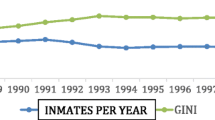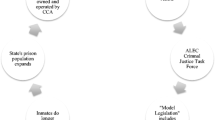Abstract
Prison privatization in the US illustrates the challenge of privatization to the traditional state monopoly over “inherently governmental” functions. From a perspective on core governmental functions, this paper provides a new logical explanation of this phenomenon and argues that prison privatization demonstrates the political rationality of governments. Conservative social control and economic neoliberalism were two major political reasons for prison privatization in the US. These factors aggravated the instrumental problems of the public prison system and reinforced the urgency to address them. This logic is applied to explain the variation in the magnitude of prison privatization in the 50 states. Drawing on the results of a Tobit analysis, this paper confirms that both political factors and instrumental factors significantly influence the preference of state governments for prison privatization.
Similar content being viewed by others
Notes
The 1940 Sumners-Ashurst Act made it a federal crime to knowingly transport convict-made goods across state lines for private commercial use, regardless of what state law allowed.
NPM, a variety of reform ideas which are not always linked to each other, calls for an engagement of the private sector and the learning from private management in public management and service delivery [32].
For example in 2003, North Dakota, Maine, Wisconsin, and Michigan only exported state prisoners.
According to a survey of 89 prison contracts in 1998 [44], 40% of in-state facilities had less than 20 h per month of on-site monitoring. This figure rose to 90% for out-of-state facilities. For in-state facility monitoring, 63% of contract monitors had some training for the task, but only 14% of monitors for out-of-state facilities had such training.
After the Second World War a period of liberal justice practice that pursued rehabilitative goals emerged. During this period, all states adopted indeterminate sentencing [48].
For example, the Anti-drug Abuse Acts of 1986 and 1988 were passed to “wage war on crime” by criminalizing drug offenses, which accounted for 55.5% of federal prisoners in 2001 [10]. The Comprehensive Crime Control Act of 1984 established mandatory minimum sentences for violent crimes and drug offenses.
For example, the County Nueces, Texas v. Texas Board of Corrections led to the state’s loss and its liability to pay the counties $20 per day for each convicted felon housed in local jails. From Sep 28, 1987 to Feb 28, 1990, Texas owed $100.3 million to its 12 counties [34].
DC is excluded due to its takeover by Bureau of Prison in 2001.
This information is based on multiple data sources.
Ten of the 20 states with a 0 level of SPP adopted SPP before 2003.
Hawaii and Alaska are not included in their research and will be assigned the median value of western states.
From 1983 to 2003, union membership decreased nationwide from 20.1% to 12.9% [17], while unionization of correctional officers increased from 44% to 51%.
During 1995–1999, the number of private state prisons increased by 140% from 98 to 238 and the number of outsourced state prisoners increased by 337% from 15,408 to 67,380. During the same period, 17 states outsourced prisoners for the first time.
For example, the five states with the highest PIOC in 1996 (Minnesota, Rhode Island, Maine, Alaska, Utah) had only an average of 283 state prisoners outsourced in 2003, while the five states with the lowest PIOC in 1996 (Alabama, Oklahoma, Mississippi, Texas, Missouri) had an average of 5,551 state prisoners outsourced [5, 11].
According to Levitt [38], the life cycle of a court order includes prefiling, filed, preliminary decision, final decision, further action, and release, often spanning two decades.
References
Baker, B. (2003). Receipts and expenditures of state governments and of local governments, 1959-2001. In Survey of current business. Department of Commerce.
Becker, F., & Mackelprang, A. J. (1990). Attitudes of state legislators toward contracting for public service. American Review of Public Administration, 20(3), 175–189.
Belbot, B. (2004). Report on the Prison Litigation Reform Act: What have the courts decided so far? The Prison Journal, 84(3), 290–316.
BJS (Bureau of Justice Statistics). (1996). Sourcebook of criminal justice statistics, 1995.
BJS (Bureau of Justice Statistics). (1999). State prison expenditures, 1996.
BJS (Bureau of Justice Statistics). (2000a). Prisoners in 1999.
BJS (Bureau of Justice Statistics). (2000b). Sourcebook of Criminal Justice Statistics, 1999.
BJS (Bureau of Justice Statistics). (2001). Prisoners in 2000.
BJS (Bureau of Justice Statistics). (2003a). Census of State and Federal Correctional Facilities, 2000.
BJS (Bureau of Justice Statistics). (2003b). Prisoners in 2002.
BJS (Bureau of Justice Statistics). (2004a). Prisoners in 2003.
BJS (Bureau of Justice Statistics). (2004b). State prison expenditures, 2001.
BJS (Bureau of Justice Statistics). (2004c). Sourcebook of criminal justice statistics, 2002.
BJS (Bureau of Justice Statistics). (2009). Prisoners in 2008.
Bozeman, B. (1987). All organizations are public: Bridging public and private organizational theories. San Francisco: Jossey-Bass.
Brown, T., & Potoski, M. (2003). Transaction costs and institutional explanations for government service production decisions. Journal of Public Administration Research & Theory, 13(4), 441–468.
Bureau of Labor Statistics. (2004). Union Members in 2003.
Camp, C., & Camp, G. (2000). The 2000 correctional yearbook: Private prison. Connecticut: Criminal Justice Institute, Inc.
Camp, S., & Gaes, G. (2001). In D. Shichor & M. Gilbert (Eds.), Private adult prisons: what do we really know and why do not we know more. Cincinnati: Anderson.
DeFina, R., & Arvanites, T. (2002). The weak effect of imprisonment on crime: 1971–1998. Social Science Quarterly, 83(3), 635–653.
Donahue, J. (1988). Prisons for profit: public justice, private interests. Washington, DC: Economic Policy Institute.
Donahue, J. (1989). The privatization decision: public ends, private means. New York: Basic Books.
Erikson, R., Wright, G., & McIver, J. (1987). State political culture and public opinion. American Political Science Review, 81(3), 797–813.
Erikson, R., Wright, G., & McIver, J. (1989). Political parties, public opinion, and state policy in the United States. American Political Science Review, 83(3), 729–750.
Erikson, R., Wright, G., & McIver, J. (1993). Statehouse democracy. Cambridge: Cambridge University Press.
GAO (General Accounting Office). (1991). Government contractors: are service contractors performing inherently governmental functions? GAO reports, GGD-92-11. Washington, November 1991.
GAO (General Accounting Office). (1996). Private and public prisons: studies comparing operational costs and/or quality of service. GAO/GGD-96-158.
Gray, V. (1973). Innovation in the states: A diffusion study. American Political Science Review, 67(4), 1174–1185.
Helms, R., & Jacobs, D. (2002). The political context of sentencing: an analysis of community and individual determinants. Social Forces, 81(2), 577–604.
Hirsch, B., & Macpherson, D. (1995). Union Membership and Coverage Database. Based on the Current Population Survey by Bureau of Labor Statistics.
Hodge, G. (2000). Privatization: An international review of performance. Boulder: Westview.
Hood, C. (1991). A public management for all seasons. Public Administration, 69(1), 3–19.
Jing, Y., & Savas, E. S. (2009). Managing collaborative service delivery: Comparing China and the United States. Public Administration Review, 69(Special Issue (Supplement No. 1)), 101–107.
Kerle, K. (1999). Jails as long-term facilities. In P. Carlson & J. Garrett (Eds.), Prison and jail administration: Practice and theory. MD: Aspen.
Knepper, P. (1991). A Brief History of Profiting From the Punishment of Crime. Paper presented at the 50th anniversary meeting of the American Society of Criminology, San Francisco, November.
Langbein, L. (1986). Money and access: Some empirical evidence. The Journal of Politics, 48(4), 1052–1062.
Lember, V. (2004). Limiting aspects of contracting out in transitional countries: The case of Estonian prisons. Public Administration and Development, 24, 425–435.
Levitt, S. (1996). The effect of prison population size on crime rates: Evidence from prison overcrowding litigation. The Quarterly Journal of Economics, 111(2), 319–351.
Light, P. (1999). The true size of government. Washington, DC: The Brookings Institution Press.
Logan, C. (1990). Private prisons: Cons and pros. New York: Oxford University Press.
Mackenize, D. (2001). Sentencing and corrections in the 21st century: Setting the stage for the future. Report submitted to US Department of Justice.
March, J., & Olson, J. (1983). Organizing political life: What administrative reorganization tells us about government. The American Political Science Review, 77(2), 281–296.
McDonald, J., & Moffitt, R. (1980). The uses of tobit analysis. Review of Economics & Statistics, 62(2), 318–221.
McDonald, D., & Patten, C. (2003). Government’s management of private prisons. Cambridge: Report of Abt Associates Inc.
McDonald, D., Fournier, E., Russell-Einhourn, M., & Crawford, S. (1998). Private prisons in the United States: An assessment of current practice. Cambridge: Report of Abt Associates Inc.
Minicucci, S., & Donahue, J. (2004). A simple estimation method for aggregate government outsourcing. Journal of Policy Analysis and Management, 23(3), 489–507.
Moe, R. (1987). Exploring the limits of privatization. Public Administration Review, 47(6), 453–460.
Nagel, I. (1990). Structuring sentencing discretion: the new federal sentencing guidelines. Journal of Criminal Law & Criminology, 80, 913–939.
National Conference of State Legislatures. (2004). Web URL: http://www.ncsl.org/programs/fiscal/tels2004.htm
National Institute of Corrections. (1996). Privatization and contracting in corrections: Results of an NIC Survey. Colorado: Longmont.
Nicholson-Crotty, S. (2004). The politics and administration of privatization: Contracting out for corrections management in the United States. Policy Studies Journal, 32(1), 41–57.
Office of Management and Budget. (1999). Circular No. A-76 (Revised).
Parenti, C. (2003). Capitalist punishment: Prison privatization and human rights. In A. Coyle, A. Campbell, & R. Neufeld (Eds.), Capitalist punishment: Prison privatization and human rights. Atlanta: Clarity Press, Inc. London: Zed Books.
Pierson, P. (1994). Dismantling the welfare state?: Reagan, Thatcher, and the politics of retrenchment. Cambridge: Cambridge University Press.
Pierson, P. (2000). Increasing returns, path dependence, and the study of politics. American Political Science Review, 94(2), 251–257.
Price, B., & Riccuci, N. (2005). Exploring the determinants of decisions to privatize state prisons. American Review of Public Administration, 35(3), 223–235.
Salamon, L. (1989). The changing tools of government action: An overview. In L. Salamon (Ed.), Beyond privatization: The tools of government action. Washington, DC: Urban Institute Press.
Savas, E. S. (1987). Privatization. Chatham: Chatham House Publishers.
Savas, E. S. (2000). Privatization and public-private partnerships. New York: Chatham House.
Shepherd, J. (2002). Fear of the first strike: The full deterrent effect of California’s two- and three-strikes legislation. Journal of Legal Studies, 31(1), 159–201.
Shichor, D. (1995). Punishment for profit: Private prisons/public concerns. Thousand Oaks: Sage.
Shichor, D., & Gilbert, M. (2001). Privatization in criminal justice: Past, present, and future. Cincinnati: Anderson Publishing Co.
Singer, P. (2003). Corporate warriors: the rise of the privatized military industry. Ithaca: Cornell University Press.
Smith, K. (2004). The politics of punishment: Evaluating political explanations of incarceration rates. Journal of Politics, 66(3), 925–938.
Starr, P. (1990). The new life of the liberal state: privatization and the restructuring of state-society relations. In E. Suleiman & J. Waterbury (Eds.), The Political economy of public sector reform and privatization. Boulder: Westview Press.
Thomas, C., Bolinger, D., & Badalamenti, J. (1997). Private adult correctional facility census (10th ed.). Gainesville: University of Florida.
Tilly, C. (2003). The politics of collective violence. Cambridge: Cambridge University Press.
Tobin, J. (1958). Estimation of relationships for limited dependent variables. Econometrica., 26(1), 24–36.
Weber, M. (1946). From Max Weber: Essays in sociology. Translated, edited and introduced by Gerth, H. H. and C. Wright Mills. New York, Oxford University Press.
Wood, P. (2003). The rise of the prison industrial complex in the United States. In A. Coyle, A. Campbell, & R. Neufeld (Eds.), Capitalist punishment: Prison privatization and human rights. Atlanta: Clarity Press, Inc.
Acknowledgement
The author thanks Bert Rockman and Trevor Brown for their enormous contribution to this research. The gratitude is also extended to Anand Desai, Robert Greenbaum, Evan Berman, Eugene Leong, Stephen Noakes, Kilian Rieder and the three anonymous reviewers. The author is responsible for any remaining error.
Author information
Authors and Affiliations
Corresponding author
Rights and permissions
About this article
Cite this article
Jing, Y. Prison privatization: a perspective on core governmental functions. Crime Law Soc Change 54, 263–278 (2010). https://doi.org/10.1007/s10611-010-9254-5
Published:
Issue Date:
DOI: https://doi.org/10.1007/s10611-010-9254-5




